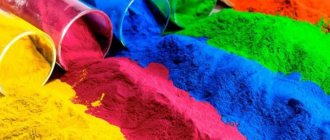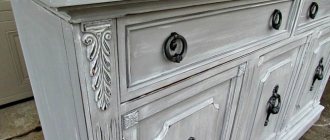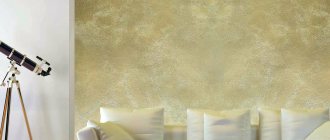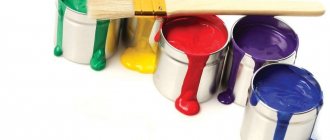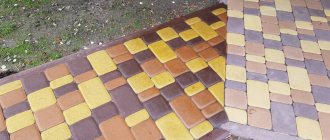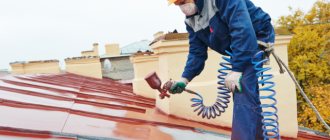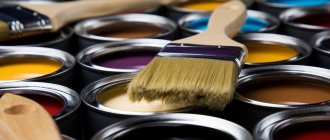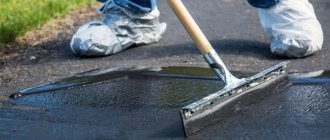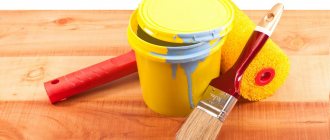What are pigments?
Pigments are dry substances or emulsions in powder form that do not dissolve in liquid. The product is intended for coloring a variety of liquid compositions: solutions, paints, concrete and various polymers. Most often used for painting building materials made from cement mortar: foundations, paving stones, curbs, facade, paving, and facing tiles. The cement pigment forms a film on top of the material.
Dye for cement mortars is intended to change the standard gray color of the material to any other. The color is sold as:
- powdery substance;
- pastes with concentrated color;
- small capsules;
- emulsions.
Such dyes are often used in the manufacture of paving slabs, curbs, paving stones and other building materials and structures.
Paint for cement mortar differs in the origin of the raw materials:
- natural. It is based on materials mined by the ore method;
- synthetic, obtained during the processing of chemicals.
Colored cement
A popular building material is concrete and cement mortar prepared with ordinary Portland cement, which after drying acquires a light gray tint. In some cases, it is required that a structure or product made of cement have a decorative “multi-colored” appearance.
To make it decorative, colored cement is used - special artificial or natural dyes are added to the solution.
Where is colored cement used?
Colored concrete and mortar are used in the production of the following products:
- Curbs, paving stones, paving slabs and garden paths.
- Artificial stone for finishing facades.
- Outdoor decor: vases, flower beds, pots and other small architectural forms.
- Colored plaster.
- Decorative brick and foam block.
Colored additives in cement
All color additives are divided into three main categories: liquid, semi-liquid and dry colors. When choosing a category option, you should take into account the operating conditions of the products.
The most optimal type of dye for all operating conditions is powdered (dry) color, which perfectly colors the structure, does not fade under the influence of ultraviolet rays of the sun, is not washed out by precipitation and does not react chemically with the sealer (water).
Dry material for coloring concrete can be of either natural or artificial origin. In both cases, the colors are a composition of fine powders of various metal oxides.
The difference is that natural dyes are obtained by grinding raw materials mined by the ore method, and in the second, the raw materials are waste and by-products of the metallurgical industry.
Widely used standard color colors:
- Black (soot or black iron oxide).
- White (titanium dioxide).
- Red (pure iron oxide).
- Brown (a mixture of red and black iron oxides or umber).
- Yellow (iron oxide hydrate).
- Green (chromium oxide).
- Blue (copper phthalocyanine).
Retail chains offer a huge selection of coloring companies that can be used to produce colored concrete mortar of various shades. In this article, we will introduce clean people to the most popular brands:
- "BAYFERROX" , manufactured by Company LanXESS (Germany). The dyes of this brand are leaders in all respects, have excellent wear resistance, are characterized by the absence of dust fractions, and also contain special substances (dispersants) that ensure the most uniform coloring of the structure. Disadvantages include high cost.
- "Yaroslavsky Pigment" (Russian Federation). The company produces pigments in a wide range of colors: red, brown, orange, green, white, black, blue. At the same time, Yaroslavl Pigment colors are distinguished by their affordable cost, environmental friendliness, resistance to harmful factors (ultraviolet radiation, alkalis, high temperature, atmospheric exposure), excellent hiding power and coloring ability.
- "PRECOLOR AS" (Czech Republic). The company offers an unlimited range of colors. At the same time, PRECOLOR AS pigments are colorfast, environmentally safe for people and animals and meet European quality standards.
- CATHAY Pigments Group (Hong Kong, China). The colors of this brand have excellent coverage, resistance to harmful factors and color saturation.
DIY colored cement
You can prepare colored concrete or colored mortar on your own.
The main condition is to maintain proportions and use clean white sand and clean water.
To obtain a highly saturated color with a minimum amount of added pigment, white Portland cement should be used.
Gray general construction Portland cement “muffles” the brightness of the shades, giving the products pastel tones. It is worth noting that the use of white Portland cement significantly increases the cost of the final product.
Judge for yourself, the average cost of a 50-kilogram bag of white cement ranges from 700 to 1044 rubles, while a bag of regular cement costs from 290 to 345 rubles for one bag weighing 50 kg.
Next, we will tell you how to make a colored cement mortar for the construction of garden paths, small areas, sidewalks and other light-loaded structures:
- Proportions of components: Portland cement 1 part, white purified sand 2.5 parts, washed granot sieving 4 parts, clean water 0.3 parts, color 5-10% by weight of cement. Practical advice! There is a limit to color saturation. In other words, there is a certain threshold of the amount of color added, when adding another portion no longer affects the brightness of the shade. Moreover, this leads to an increase in cost and a harmful phenomenon - moisture withdrawal (in some cases this will deteriorate the quality of the product). The percentage of dye indicated above is the so-called “threshold”.
- High-quality colored building material will be obtained provided that the components are evenly mixed. Therefore, a concrete mixer should be used to prepare colored concrete. First, sand and gravel are loaded into the concrete mixer. Mix and add cement. Mix again and add dye. The concrete mixer is left turned on until the mixed mass acquires a uniform color.
- Add water in small portions while mixing the components. Water is added until the required consistency of concrete (mortar) is obtained.
- Colored concrete (mortar) is ready for use.
Conclusion
On the Internet you can find information on how to make colored cement with your own hands without using “branded” concrete colors.
To save money, users are encouraged to mix in certain proportions: calcium chloride, lime, dry lime paint and laundry soap.
It is worth warning that in this way you can save a certain amount, but not achieve the desired result in terms of color saturation and durability.
Therefore, if you want the result of your work to be a magnificently decorative product, “don’t be clever” and use special dyes from well-known brands.
Source: https://cementim.ru/tsvetnoj-tsement/
Advantages and disadvantages of colored cement composition
Cement is often colored to provide a decorative appearance and reduce the cost of facing. After the composition with the color has hardened, it does not have to be painted on the outside, and even in the process of destruction of the layer, the material retains its original color.
Advantages of pigments:
- absolute safety for humans and environmental cleanliness;
- economical consumption. Even with a small amount of product it is possible to obtain a rich color;
- the ability to give monolithic structures the shade that is necessary to implement the design idea.
The composition has significant advantages, but there are also disadvantages:
- Over time, painted concrete loses the shade required by design, it fades in the sun and changes due to the influence of chemicals. After years of operation of the structure, the color becomes less saturated, and in addition a yellowish tint appears;
- the dye increases the cost of building construction.
The main disadvantage of this coloring method is the high financial costs.
How to prepare colored concrete
And this is a different approach. This is not something that is applied externally. This is what dissolves inside. Simply put, to make a colored solution, you need to mix the pigment with the concrete components. It’s a good idea to learn how to mix the desired color using design patterns.
To get exactly the color you want, use only white cement for the mortar.
Some people love calm pastel colors, others need bright sensations. To please yourself, you need to know the proportions of the powder. Coloring powder of course. What did you think? Here is a small sign that you can cut out and hang on your refrigerator. It gives the average pigment consumption to obtain paint of the required intensity.
| Color intensity | Amount of pigment per 100 kg of cement |
| Pastel tone | 1-2 kg |
| Medium intensity tone | 3-4 kg |
| Saturated color | 4-6 kg |
Concrete paint for exterior use
A few more tips:
- If you are preparing a dark color, you can add less dye.
- If you want to get a bright color of light colors, add a little more powder.
- If you want the tone to be less intense, add white dye.
- To obtain a more saturated shade, do not use a lot of water.
Look at the picture. This way you can get some colors from others. I wonder if there is a person who, in order to create brown, will buy blue, red and yellow?
Kneading colored concrete is like eating a pound of raisins. Follow the technology:
- First, mix the filler (this is sand and crushed stone). Thoroughly.
- Then add cement. Mix again for 20 seconds.
- Lastly, pour water. Stir everything for another 2 minutes.
There are dyes that are mixed not with dry ingredients, but with water.
Mixing dye with cement
Before painting the cement mortar, a color scheme with the desired color is selected. The shade changes depending on the mixing ratio. Packages usually indicate a color sample for various proportions. After final mixing, the dye for the solution is added to the finished mixture, then it is thoroughly mixed, preferably with a concrete mixer. The result is the most durable color possible.
The coloring composition for cement mortar is used to add to concrete with strong atmospheric and mechanical influences and increased trafficability.
There are several important characteristics of the coloring composition; they are taken into account before painting cement:
- resistance to fading for a long time;
- protection from moisture. The composition should not be washed away, dissolved or washed off with water;
- immunity to alkaline liquids;
- long-term color retention.
Properties of dyes for concrete
In addition to unearthly beauty, dyes also have other properties:
- They radically change their appearance. Cement dyes have good hiding power and therefore completely transform the gray base.
- Resistant to fading. Such an indicator as low oil absorption allows the color to remain for many years without changing. This makes it possible to use paints outdoors.
- They do not lose their appearance when exposed to ultraviolet radiation or precipitation.
- Not susceptible to the aggressive alkaline environment of concrete structures.
- Metal pigments are resistant to water corrosion. Therefore, when in contact with moisture, they do not change color.
- Special colors make concrete dust-free, which protects buildings from destruction and gives the surface increased wear resistance.
- The dyes are easy to use, but require adherence to technology.
Paint for the ceiling in an apartment: which one is better?
Characteristics and properties of pigments
Pigments available in a wide variety on the market, offered by manufacturers in various release forms, differ in their characteristics.
Pigment is a dry powder that, once dry, becomes resistant to water, oils and solvents.
Required qualities
Paint for Portland cement mortar must have the following qualities:
- high degree of dispersion. The finer the grind, the easier it is to mix the composition, it will turn out more rich and one-dimensional;
- good covering power. Indicates the ability of the composition to cover the natural color;
- resistance to alkaline environments contained in cement;
- oil absorption capacity – the ability of a product to retain oily substances on the surface. Mostly calculated for 100 g of color, the indicator is in the range of 40-100 units. As the value decreases, the consumption of the substance decreases;
- resistance to ultraviolet radiation. The high-quality composition does not fade in direct sunlight. Natural pigments have the best characteristics; synthetic products are more prone to discoloration;
- affordable price. Pricing is primarily based on the complexity of the technology, the amount of labor required and the brand markup.
Among all the additives to the solution for changing color in construction, the most popular is iron oxide color. Such substances have high resistance to fading, durability and color saturation. The compositions are often used for the manufacture of various types of tiles, decorative coatings, tiles and other products: concrete rings, floors, walls, etc.
This coloring is used to create tiles for sidewalk paths, borders and the like.
Primary dye colors
The most common primary dye colors:
- white. To obtain it, titanium dioxide (TiO2) is mixed with white cement;
- black. Can be obtained by adding ready-made pigment, soot or carbon monoxide;
- green. To create a green tint, chromium oxide (CrO2) is suitable;
- brown. Iron oxide (Fe2O3) will help convey the brown color;
- red. The reddish color is achieved by adding iron oxide;
- yellow. Iron oxide is used.
The colors listed are the most common and have already proven themselves. There are other shades, but they are expensive or come with disadvantages. Blue dye - phthalocyanine tinting is short-lived: it quickly loses color, is washed off with water and fades.
How to choose the right cement
To obtain colored cement, a mixture of any manufacturer and brand is painted, but concrete is always painted without slag additives. The standard color of concrete is gray; depending on the technology, it may have a lighter or darker color. There are white cement options.
To make the shade more saturated, you need to increase the amount of pigment
Things to consider:
- the gray color will affect the final shade of the concrete. It is recommended to initially correct for darkening of the composition in comparison with samples on the packaging or bottle;
- It’s easier to give dark cement cold tones: green, blue and gray;
- the simplest effect is “wet asphalt” and dark brown compounds;
- To create light and pure tones, it is better to use white cement. With its help you can create: pink, light green, yellow, beige.
How intense the final color and its purity will be directly dependent on the type and coverage of the additive. Cement particles interact with the dye, sticking together and forming a special color. The color weakens somewhat under the influence of external influences, the shade will change slightly over time.
Cement Mortar Paint
-> Construction of country houses, cottages, construction of baths – -> Useful information
Paint for cement, cement mortar, floors: polymer-cement coatings and others, video and photo
In this article we will talk about how to make cement paint with your own hands and what this coating is.
In addition, you will learn about which coloring compositions are suitable for application to cement plasters and other structures with similar characteristics.
Ready-made formulations are quite expensive
We paint cement cheaply and efficiently
Paint for cement plaster ensures durability and reliability of the finish
Is there a universal, durable and at the same time inexpensive paint for cement floors? Yes, there are such coatings and there are many of them, but the most affordable of them is the solution that you will make yourself.
It is no secret that cement itself can demonstrate the best adhesion to a cement floor or wall plaster. So why not make your own paint based on this material!
Production of coloring composition
Carbon black is a dye used for construction purposes.
Cement paints are compositions based on Portland cement with pigments and integrated fillers - additives responsible for the intensity of hardening, hydrophobicity and strength of the coating.
It is not difficult to prepare a simple composition at home.
We do it this way:
- Pour distilled water into a plastic container (if distilled water is not available, you can use rainwater).
- Constantly stirring the water with a paint brush, add cement in small portions.
- After the solution has acquired the consistency of liquid sour cream, add a suitable color (the best option is a color for mixing into water-based paints).
- Next, mix the solution until it acquires a uniform color.
- If cement paint is made for future use, it is advisable to use a bucket and a drill with a special attachment for mixing. The dosage in this case is 2 kg of Portland cement per 10 liters of water.
Important: If the paint is stored in finished form for more than an hour, the cement base will precipitate.
Therefore, before use, the composition must be thoroughly mixed again, and as it thickens, small portions of water can be added to the solution.
The resource of the solution is small, as a rule, it is 3-4 hours, so you should prepare a composition that you will have time to use during this time.
Painting technology
Application of cement paints instead of traditional plasters
Painting a cement floor or plaster walls is carried out in two steps:
- Apply the first liquid layer with a wide brush. We try to rub the composition into the surface being treated as much as possible.
- A day after applying the first layer, we again prepare the tinted solution, but a little thicker than the first time. Apply this layer with a velor roller. To compensate for defects in wall plaster, you can apply painting with a textured roller.
On large surfaces, paint can be applied using a spray gun, which will speed up the pace of work and have a positive effect on the quality of the finished result.
Important: To eliminate the possibility of the paint drying out, before applying the solution, it is advisable to wet the surface with water an hour before painting. In addition, care should be taken to ensure that the drying surface is not exposed to direct sunlight during the day after painting.
By the way, the solution, which you can prepare at home, can be used to coat metal structures, and it protects against corrosion no worse than Zinga electrically conductive paint.
The composition is applied to metal structures after preliminary moistening, which will ensure the necessary adhesion.
It is not recommended to paint metal under the hot sun, as the iron will heat up and the applied layer of cement will dry out and crack.
Despite the fact that the price of home-made cement paint is cheap, this composition, if applied correctly, will last about 10 years.
Factory-produced polymer-cement compositions
In the photo - applying polymer cement impregnation to a concrete coating
In addition to self-made coatings, the market offers factory-produced polymer-cement paint that meets the requirements of GOST 19179-73.
The paint composition includes the following components:
- Portland cement;
- ground lime;
- emulsion of synthetic polyvinyl acetate resins;
- pigments;
- sand or ground limestone;
- asbestos dust.
These coatings are characterized by short drying times, elasticity, resistance to the negative influences of environmental factors, and high adhesion to the concrete surface.
Factory-made polymer cement paint is produced in a limited range of colors:
- white;
- yellow;
- light yellow;
- terracotta;
- beige-pink;
- light green,
- gray;
- light blue.
These compositions are sold in two-pack packaging.
One package contains a pigmented emulsion, and the other a dry mixture of cement with fillers.
Directly on site, all components are mixed and dissolved with water in accordance with the manufacturer’s instructions.
Ready-made paint is used for external treatment of concrete, brick, metal and wooden structures and structures in order to provide aesthetic benefits and increase the durability of the treated surfaces.
Important: Polymer-cement compositions are characterized by high resistance to critical temperature values, and therefore can also be used as fire-retardant paints for Polistil metal.
Application of the composition is carried out at an ambient temperature of at least 20 degrees Celsius. Drying time is 2 hours.
Selection of pigments for tinting cement
A variety of pigments that can be used to color cement mortar
In the industrial production of cement-containing paints, the following types of colors are responsible for the color design:
- titanium dioxide – white;
- red iron oxide - red;
- yellow iron oxide - yellow;
- green chromium oxide - green;
- black iron oxide - black.
By mixing the above pigments, you can get a wide range of color solutions.
Industrially used cement mortar paint must meet the following requirements:
- be resistant to burnout;
- do not dissolve in water;
- be resistant to alkaline and acidic environments.
Conclusion
Having cement and a certain amount of pigments in stock, you can produce high-quality and reliable paint, the price of which will be much more affordable than factory-produced materials (see also the article “Marbled paint: features of selection and application”).
Testing before work
Before painting all the cement, it is recommended to carry out testing:
- You should not immediately mix the entire material with the color, because there is a risk of incorrect dosage. Initially, a trial batch is made, it will help identify potential problems and possibilities for solving them;
- When adding a large amount of color, there is a risk of cracking. During the hardening process, the pigment absorbs a lot of moisture, taking it away from the cement. It is possible to prevent negative effects by regularly wetting the coating, but this is only relevant if the active phase of water absorption before hardening is indicated;
When using gray cement, the shade turns out to be desaturated and muted.
- The best option is to pay more attention to the coloring of cement and choose a more saturated or suitable pigment. To prevent negative effects, a plasticizer or moisture retention components can be added to the mixture to maintain the correct course of the hydration process;
- It is necessary to mix the composition thoroughly to avoid stains of a darker color and places with a gray tint.
Applying paint to the finished surface
An alternative option for using pigment is to paint ready-made structures with cement.
Features of the method
The difference between the method and the previously described one is the possibility of painting the cement mortar after it has hardened. After pouring the screed or plastering the wall, a kind of paint is applied to the surface. According to the principle of application, the method does not differ from painting metal, wood or plastic. The only fundamental change is a deeper impregnation of the composition.
The quality of colored cement is higher than when processed with conventional paint. The dye penetrates the base deeper, so even if a chip appears, the decorative appearance is not lost. Cement painting provides a change in appearance and provides protection to the finish.
Already rebuilt structures - walls or paving slabs, can also be painted
Types of Dyes
The most common dyes are acid-based. Their features:
- found in all popular colors;
- used for facade work and interiors;
- sprayers or a special brush (without metal elements) are used for application;
- after treating the cement, the remaining acidic environment is washed off with water;
- the compositions are wear-resistant, resistant to fading and burnout.
It is better to use water-based acrylic paints for bricklaying; they have a richer color variety and are inexpensive. If the desired color is not available, you can mix several formulations. The acrylic-based color easily penetrates into the concrete and does not need to be washed off. The end result will be rich and long-lasting color.
At home, colors are often used to create paving stones. The solution with the addition of pigments is poured into molds and the material is allowed to dry completely. If you are wondering whether it is possible to put such paving stones in places with high traffic, definitely yes, because they are not inferior to commercial options.
Methods for coloring concrete material
There are two ways to paint concrete: inside or outside. Each option has its own characteristics:
- Painting "outside". The coloring solution consists of the paint itself, a solvent and a fixative. It is applied to a dry surface and penetrates only 2 mm. This is a cheaper and simpler method that allows you to paint even old tiles or walls, and it is quite economical. The downside is that the paint wears off over time and needs to be renewed every few years. The more layers there are, the brighter the color will come out.
- Painting from the inside. The coloring pigment is introduced into the raw cement mixture and colors it completely. The color lasts forever, does not require updating, and the finished product is not susceptible to scratches or cracks. Its disadvantage is the high price compared to external painting.
Experts advise using the first method when painting large surfaces, and the second for small items.
Recommendations
The user will be interested in additional tips:
- Before applying the solution, the surface should be carefully prepared, otherwise there is a risk of cracks and poor adhesion. It will be useful to learn what concrete contact is;
- Proper preparation and use of cement is the key to surface integrity for a long time. There are many recommendations on how to properly dilute cement to work in various conditions and protect against negative phenomena during operation;
- The composition of the mortar for laying bricks must be prepared taking into account the brand of the block. To create a monolithic building, it is better to select a composition of the same brand;
- Cement-sand plaster is the best way to level walls in apartments, since it is inconvenient to mix cement and there is nowhere to get sand.
DIY composition
You can make a simple dye at home. It’s not difficult to even get a large number of shades if you know how to make pigment for concrete with your own hands. In terms of price, it will not be expensive, but will have some disadvantages.
If you use a low-quality dye, then after painting the product will be negatively affected by sunlight and temperature changes. Simple dyes are usually used for decoration. The dry composition is mixed with water or a solvent. Before preparing, you must also take into account the color of the concrete.
READ Instructions for using liquid glass for concrete
To lighten the white color, you need to add only 1-2% titanium dioxide. To prepare paving slabs, it is better to add mineral-based pigments in a proportion of 1-5%.
It is advisable to first study the range of shades that can be obtained after adding a pigment shade. For example, white color is obtained by adding chalk or limestone. Black pigment for concrete can be made using soot, but during use it is quickly washed off. It is better to use black iron oxide, which is considered more durable.
You cannot load all the components at once and simultaneously, since good dispersion cannot be achieved this way.
